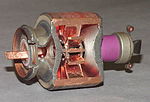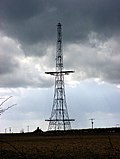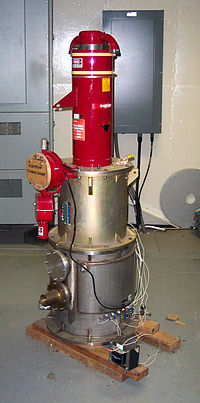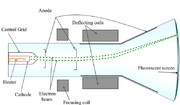Search results
Appearance
The page "Split anode" does not exist. You can create a draft and submit it for review or request that a redirect be created, but consider checking the search results below to see whether the topic is already covered.
- Cavity magnetron (redirect from Split-anode magnetron)was the split-anode magnetron, also known as a negative-resistance magnetron. As the name implies, this design used an anode that was split in two—one...52 KB (6,453 words) - 23:07, 27 October 2024
- Institute in Berlin, were added as consultants. The first apparatus used a split-anode magnetron purchased from Philips in the Netherlands. This provided about...151 KB (22,275 words) - 23:04, 2 November 2024
- Kinjiro Okabe (section Split-anode magnetron)1929 (No. 1,735,294). His work continued, and based on developing the split-anode device, he was awarded the Doctor of Engineering degree in 1928. Okabe...7 KB (920 words) - 19:47, 6 July 2024
- been developed using new principles; the Barkhausen–Kurz tube and the split-anode magnetron. These could generate a few watts of power at frequencies up...68 KB (6,993 words) - 14:11, 5 November 2024
- [citation needed] In France in 1934, following systematic studies on the split-anode magnetron, the research branch of the Compagnie générale de la télégraphie...102 KB (12,037 words) - 03:57, 27 October 2024
- other information using glow discharge. The glass tube contains a wire-mesh anode and multiple cathodes, shaped like numerals or other symbols. Applying power...22 KB (2,616 words) - 21:31, 29 October 2024
- List of vacuum tubes (section CRT anode rectifiers)External anode, liquid convection cooling N – External anode, natural convection air cooling S – External anode, conduction cooling V – Vapor cooled (anode is...329 KB (40,580 words) - 23:52, 20 October 2024
- before its invention the only sources were the Barkhausen–Kurz tube and split-anode magnetron, which were limited to very low power. It was invented by the...27 KB (3,310 words) - 09:10, 21 October 2024
- An electrical engineering researcher and professor who developed the split-anode magnetron. Jirō Osaragi (1897–1973). A popular writer in Shōwa period...25 KB (2,221 words) - 22:21, 3 November 2024
- first oscillator which could produce power at UHF frequencies; and the split-anode magnetron which by the 1930s had generated radio waves at up to 10 GHz...34 KB (3,528 words) - 08:39, 12 September 2024
- are: a thermionic cathode, first and second grids, and a plate (called anode in British English). There are several varieties of tetrodes, the most common...34 KB (4,294 words) - 16:44, 16 October 2024
- ionosphere). He started a project using a Barkhausen–Kurz tube, then tried a split-anode cavity magnetron developed by Kinjiro Okabe at Tohoku University, but...11 KB (1,516 words) - 18:43, 13 May 2024
- electron-emitting cathode and an anode. Electrons can flow in only one direction through the device—from the cathode to the anode. Adding one or more control...120 KB (15,367 words) - 03:53, 22 September 2024
- magnetron. This took the form of a central cathode and a coaxial cylindrical anode split into two halves, with an axial magnetic field produced by an external...8 KB (847 words) - 13:46, 29 June 2024
- November 1939. The only other microwave device known at that time was the split-anode magnetron, a device capable of generating small amounts of power, but...21 KB (2,502 words) - 00:57, 9 October 2024
- all negative resistance oscillations in vacuum tubes; for example the split-anode magnetron was said to work by "dynatron oscillation". An advantage of...24 KB (2,511 words) - 09:39, 25 August 2024
- Cathode-ray tube (section Anode)hot cathodes allowed for lower acceleration anode voltages and higher electron beam currents, since the anode now only accelerated the electrons emitted...266 KB (29,009 words) - 04:59, 2 November 2024
- larger current of the anode-to-cathode path. In a two-lead thyristor, conduction begins when the potential difference between the anode and cathode themselves...27 KB (3,391 words) - 12:35, 31 October 2024
- with oxidation of oxide ions occurring at the anode and reduction of water occurring at the cathode. Anode: 2 O2− → O2 + 4 e− Cathode: H2O + 2 e− → H2 +...23 KB (2,924 words) - 20:43, 5 May 2024
- into the anode compartment and flows into the cathode compartment. Similarly to the membrane cell, chloride ions are oxidized at the anode to produce...16 KB (1,811 words) - 03:09, 7 October 2024
- Rays of Positive Electricity and Their Application to Chemical Analyses/Negatively Charged Particlesthe positive particles and equal to the potential difference between the anode and cathode of the discharge tube. To take a definite case, let us suppose
- he kills a deer, he tans the hides, he stretches the skins, he makes an anodized aluminum frame, he learns how to extrude and weld… all in about five minutes
- forming at the anode. The current would continue to flow until all the lead bromide was turned into lead and bromine. Q3) It takes energy to split up a compound
















